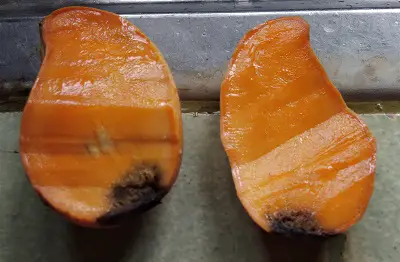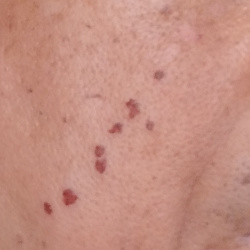Scientists have exerted efforts to curb the damaging effects of the mango pulp weevil on the mango industry. These are human interventions to the spread of the pest. But can mangoes, by itself, counter the damaging effects of the mango pulp weevil? This article proposes these plants might defend themselves through natural secretions.
Plants evolve their defense to threats to its survival (Ryan, 1990). To prevent attacks on their fruits as a vehicle of sustaining the species, plants secrete substances that make them vulnerable to pests. They produce toxic substances to animals, such as alkaloids, saponins, volatile oils, resins, and phenolics. Or maybe a highly acidic sap that can kill intruding insects?
This article presents the case of a highly acidic sap that probably helped control the mango pulp weevil infestation. These pesky insects seem to have miraculously disappeared from the mangoes we have in the yard.
Mango Pulp Weevil
The latter mechanism may be at work in the recent experience I’ve had with mangoes grown just within our lot. I planted three mango plants way back in 2004, and these have grown huge. I always have to clean the lawn because the fallen leaves clutter the yard..
Almost five years ago, I posted an article titled “Mango Pulp Weevil: A Pest Control Problem in Palawan Island” I saw first-hand how the mango pulp weevil (Sternochetus frigidus) escapes from the mango pulp to again re-infect other mangoes with its pulp destructive reproductive strategy.
The mango weevil grows within the mango pulp! It’s fast-moving as I documented two of them quickly escaping from the pulp within 12 seconds (see video on the Mango Pulp Weevil) below.
See how fast that is? Catch them right away once you see them to avoid further mango infestation.
This reproductive strategy is damaging to the mango industry, where many farmers depend on a source of livelihood.
Hence, out of curiosity, after years of not benefiting much from mangoes grown in our yard, I harvested fifty mangoes from our naturally grown mangoes. We did not spray any pesticide on the two 29-year-old trees through the years.
I wrapped the harvested green but mature mangoes with paper and cut a diamond hole to monitor its ripeness as the days go by.
Categories of Mangoes
Anticipating mango weevil, I listed three categories on the whiteboard:
- 1) uninfected, normal mangoes,
- 2) infected mangoes,
- 3) mangoes infected with other mango diseases.
I added the last category, noting that there is a tendency for the mangoes to rot (Figure 1) even before they ripen.

After consuming and giving some mangoes to family and friends while asking for their feedback on the state of the mangoes, the following are the results:
- Uninfected, normal mangoes: 48
- Infected with mango weevil: none
- Infected with other diseases: 2 (mango rot)
More Acidic Sap in Mango Controls Mango Pulp Weevil?
While this may be just anecdotal evidence, the mango may have developed a natural immunity against the mango weevil. The mango sap had become more acidic than usual, as when I harvested the mangoes, trickles of acid from the harvested portion hit my face. I felt a little burning sensation but regarded it lightly.
However, after taking a bath and looking at the mirror, I noticed ugly streaks of burnt skin run through my face (Fig. 2). I never thought it could happen, although mango sap can cause phytoallergy among mango harvesters when I searched online. Thankfully, the burnt skin healed after several days.

While detaching the mango from the petiole, spurts of white sap burst forth from the fruit. There is intense pressure to escape sap from the mango. Detaching a mango from its attachment should be done carefully to avoid skin contact with the highly corrosive fluid.
Mango Sap Hypothesis
I understand that a rigorous study needs to be done to affirm this observation. The hypothesis for that full-scale study would be: The highly acidic sap of mangoes can kill or prevent mango weevil eggs from being inoculated in the mango pulp. The mango may have developed natural resistance to the mango weevil as a pest.
This condition may be a demonstration of Barry Commoner’s third law of ecology: Nature knows best.
Nature knows best.
– bARRY cOMMONER
References
Ryan, C. A. (1990). Protease inhibitors in plants: genes for improving defenses against insects and pathogens. Annual review of phytopathology, 28(1), 425-449.
© 2019 May 23 P. A. Regoniel
[cite]



When people get baffled by unexplained events or circumstances that may or may not be related to their proximity to balete, this further reinforces their belief.